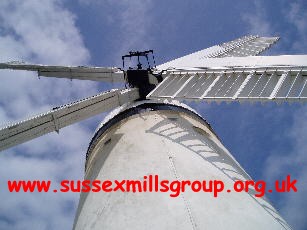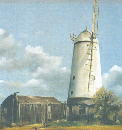|
 PEVENSEY, WEST SUSSEX [NGR: TQ619043] PEVENSEY, WEST SUSSEX [NGR: TQ619043]
Stone Cross Windmill is located on high ground in the village of Stone Cross, just north of Eastbourne in East Sussex. The Tower Mill was built for Mr Samuel Dallaway and work commenced on site in 1875 with the construction of the brick tower by Mr Thomas Hunnisett, a builder of Gardner Street, Herstmonceux. The tower was then equipped with machinery by the well-known millwright, Mr Stephen Neve & Sons of Warbleton, and the work was completed in 1876 ready for operation. This windmill was the last of her type to be built in Sussex and includes many of the design features that had evolved over the years.
She ceased working commercially in 1937, and in 1952 was officially designated as a Grade II* Listed Building. In the following years some work was carried out by the owner(s) but by the 1990s she was in a very poor state of repair and so in 1995 the direct intervention of Wealden District Council and Sussex Mills Group, Stone Cross Mill Trust was specially set up to legally acquire the ownership of the mill with the specific aim of restoration and preservation. In 1996 the Trust became a registered charity.
A plan to restore the mill to working condition was produced and costed with generous grants from the Heritage Lottery Fund, the South East England Development Agency, East Sussex County Council, Wealden District Council and many other funding charities, work commenced in September 1998. The project was divided into three phases, (a) the mill tower and all machinery, (b) the roundel at the base of the tower, and (c) the oak-framed Mill Store, and contracts were duly placed.
Volunteers continue with the preservation and maintenance for the interest of future generations of such a fine example of our Industrial Heritage.
The mill is open to the public on Sunday afternoons. Whilst there is no car parking at the mill, there are spaces in the adjoining roads.
Arrangements can be made for organised groups to visit privately. Donations are invited to enable us to continue the work and souvenirs and our own stoneground flour are on sale in the Mill Store. New members are always welcome and may help with maintenance, fundraising, and guiding our visitors on open days. |  |
The history of Stone Cross Windmill
Extracted from the publication "A guide to Stone Cross Windmill" by J. Roberts & R. Hall
and from the Stone Cross Mill Trust leaflet
Some photos kindly supplied by Dave & Hazel Picton
|
|
|
High up, overlooking historic Pevensey Bay, is Stone Cross Windmill. Originally called Blackness Mill and now sometimes called Westham or Pevensey Mill, she was built on Windmill Green, Stone Cross in 1875-6.
She is a brick tower mill, the bricks having been made in a local brickfield, no longer in existence. The tower was contracted to be built by Honeysett of Herstmonceux and was made of bricks cemented over inside and out. The tower originally had a wooden stage with round windows above and two semi-circular ones below. This is now replaced by a roundel which did not show the fineness of the workmanship found in the tower.
The interior fittings which were installed in the year following the building of the tower, were by Stephen Neve of Heathfield and cost in total £ 2,700. This is of special interest, as this is the only tower mill connected with Neves, who were renowned for their fine smock mills in the Sussex area.
|
 The ironwork was founded at John Every's Works which was in Lewes and was hoisted into the mill from a ship's mast (quite widely used for the purpose). She had four patent sweeps (sails) and three sets of stones. The ironwork was founded at John Every's Works which was in Lewes and was hoisted into the mill from a ship's mast (quite widely used for the purpose). She had four patent sweeps (sails) and three sets of stones. Stone Cross mill was built for Mr. Samuel Dallaway, cousin of the then owner of "Cherry Clack" Windmill at Punnetts Town. She was worked by Mr. Samuel Dallaway until 1878 when Mr. Frederick Dallaway took over. The mill continued throughout her working life in the Dallaway Family, Henry Dallaway taking over in 1895, and continuing to work her until she finished work in 1935. | | 
Frederick Dallaway |

Henry Dallaway |
Her working life, however, was not without incident. A well-known local miller, Mr. Gilbert Catt, remembered how the sweeps ran away on their own account one very stormy night, breaking the spokes of the brakewheel as they did so. The brake is supplemented by a chain fixed through the spokes of the brakewheel and round a nearby beam; this chain snapped the spokes as the sweeps went round. |
 |

From a painting
by G. Dobbin |
In a gale in 1925 two of the sweeps were blown off and were not replaced until the mill's recent restoration project. The gale must have been very severe as it was said that debris was found over 2 miles away in Pevensey. The mill was then worked on two sweeps until the end of her working life. |
Shortly after this, as the War approached, the Army took her over and she was used as an observation post. Many of the soldiers recorded their stay by autographing the inside of the mill cap and walls.
After the War the mill stood unattended until the1960s. In January 1962 a Mr. John Glessing drew up plans for, and was granted permission, to convert the mill into a house. Nothing came of it because Mr. Ron Hall, then owner of the Mill House, bought the mill as well; thus uniting the property as a whole. This comprises the Mill, Mill House, Office, Granary and Field. Mr. Hall, instead of converting the mill, started the process of restoring the mill, one of the most complete in the county.
 |
The first job to be taken in hand was the renewal of the old Kentish style fanstaging, the timbers of which were found to be very rotten and were in a dangerous condition. Mr. Hall dismantled the rotting timbers and, using them as a pattern, completely rebuilt the stage, keeping faithfully to the original design. This was quite an undertaking, but was completed, along with other sundry repairs, and finished off with a good coat of paint. The shutters were removed from the sweeps to relieve wind resistance. These were numbered and stored in the mill. |
In 1994 after some discussion with the Hall Family, Sussex Mills Group in conjunction with Wealden District Council produced a solution to safeguard the future of the mill whereby a charitable trust should be formed and ownership of the Listed Building should be given over to the Trust for restoration and preservation as a working mill in perpetuity. Stone Cross Mill Trust was formed in 1994 and transfer of ownership of the mill was competed in November 1995. Charitable Status was granted at the beginning of 1996 and the serious business of fundraising began.
In 1998 the Heritage Lottery Fund awarded the Trust a grant equal to 75% of the estimated total cost of the restoration, with the remainder to be found by the Trust. The restoration of the mill tower and machinery commenced in November 1998 and was completed in February 2000, when the mill worked for the first time in 60 years and produced flour. The next two years saw the rebuilding of the roundel and Mill Store, internal and external decorations, installation of electrical power and the restoration of the Armfield dresser on the Stone Floor.
The aim of the project has been to restore Stone Cross Tower Windmill, a Grade II* Listed Building, to working condition as she was in 1880, and to open her for the enjoyment and education of all ages.
Stone Cross Windmill contact :
 
|
|























